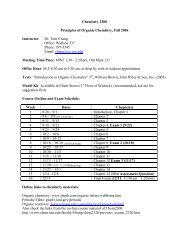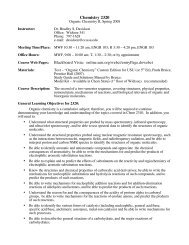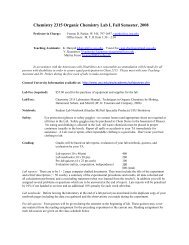Final Exam Review Sheet Chemistry 1120 Spring 2003 Dr. Doug ...
Final Exam Review Sheet Chemistry 1120 Spring 2003 Dr. Doug ...
Final Exam Review Sheet Chemistry 1120 Spring 2003 Dr. Doug ...
- No tags were found...
Create successful ePaper yourself
Turn your PDF publications into a flip-book with our unique Google optimized e-Paper software.
<strong>Final</strong> <strong>Exam</strong> <strong>Review</strong> <strong>Sheet</strong><strong>Chemistry</strong> <strong>1120</strong><strong>Spring</strong> <strong>2003</strong><strong>Dr</strong>. <strong>Doug</strong> Harris• <strong>Review</strong> the structural and polarity characteristics of carbonyl groups.• Know IUPAC naming system for alcohols, aldehydes, ketones, carboxylicacids, esters, and “aniline” amines. <strong>Review</strong> the common naming system ofamines. <strong>Review</strong> the name and structure of benzoic acid.• Know greek designations for the carbons in carboxylic acids.• Given a series of molecules of similar mass, be able to rankboiling/melting points and relative solubilities.• Know the differences between isomers (constitutional, stereo,enantiomers, and diastereoisomers).• Identify chiral/achiral molecules.• <strong>Review</strong> the oxidation/reduction scheme that we have heavily emphasizedin the study of alcohols, aldehydes, ketones, and carboxylic acids.• Predict the product that would result upon addition of water or hydrogen toan aldehyde or ketone.• <strong>Review</strong> acetal/hemiacetal formation. Know reactants and products. Beable to recognize acetals and hemiacetals.• <strong>Review</strong> classification of monosaccharides(aldose/ketose/triose/tetrose/pentose/hexose/aldohexose/ketohexose/etc).• Know Fisher projections of D-glucose, D-galactose, and D-Fructose. Beable to draw their enantiomers. <strong>Review</strong> the definition of D and L isomers.Be able to convert to the cyclic structure and vice versa. Know thedifference between anomers that can form. <strong>Review</strong> the concept ofmutarotation.• Know the constituent monosaccharides and type of glycosidic bonding inmaltose, lactose, and sucrose. Know which of these disaccharides arereducing sugars and why. Given a disaccharide, identify the type ofglycosidic bond present.• <strong>Review</strong> how carboxylic acids can behave as acids. <strong>Review</strong> how to preparecarboxlic acid salts.• <strong>Review</strong> the esterification and saponification reactions.• <strong>Review</strong> the main structural components of waxes, triacylglycerols,glycerophospholipids, sphingolipids, glycosphingolipids, and steroids.• Know the difference between saturated fatty acids and unsaturated fattyacids. Understand structural reasons for differences in melting points.• <strong>Review</strong> the hydrogenation of triacylglycerols.• <strong>Review</strong> Figure 18.16 and know components of the fluid mosaic model ofthe cell membrane.
• <strong>Review</strong> the term “heterocyclic compounds”. Know what a heterocycliccompound is.• <strong>Review</strong> the different degrees (primary, secondary, tertiary) of alcohols andamines.• <strong>Review</strong> the amide synthesis reaction and base-hydrolysis of an amidereaction.• <strong>Review</strong> the general characteristics of amine-containing drugs.• <strong>Review</strong> Table 20.1. Be able to classify a protein given a name andfunction.• <strong>Review</strong> Table 20.2. Know structures, names, three letter abbreviations,and family classifications (polar, nonpolar, acidic, and basic) of the 20amino acids.• <strong>Review</strong> the primary, secondary, tertiary, and quaternary levels of proteinstructure.• Be able to locate the N or C terminus of a given peptide sequence.• Predict the structure of an amino acid at its pI, pH below pI, and pH abovepI points.• Be able to assign a name to a short peptide.• <strong>Review</strong> the different conditions that may cause a protein to denature.• <strong>Review</strong> the reactions and classifications of the 6 different enzyme classes.Recognize the suffix that identifies many enzymes.• <strong>Review</strong> competitive, noncompetitive, and feed-back inhibition.• <strong>Review</strong> Figure 21.7• <strong>Review</strong> the enzymes used as diagnostic tools in the Health Note sectionof pages 678 and 679.• <strong>Review</strong> the components of nucleosides and nucleotides. You will not needto memorize the exact structure of the nitrogenous bases.• <strong>Review</strong> the bases found in DNA and RNA, respectively. <strong>Review</strong> thehydrogen bonding that links the base pairs in both strands of the DNAdouble helix.• <strong>Review</strong> the terms replication, transcription, and translation. <strong>Review</strong> themain characteristics of each of these processes as was covered in lecture.• Know the definitions of exons and introns.• Understand the meaning of the terms metabolic, catabolic, and anabolicreactions.• <strong>Review</strong> how the hydrolysis of ATP can be used to “drive” another reaction.• Be able to write an overall equation describing a coupled reaction with thehydrolysis or formation of ATP (as we did in class).• <strong>Review</strong> the vitamins necessary to create the coenzymes NAD, FAD, andCo-A. <strong>Review</strong> the oxidized and reduced forms of NAD and FAD. <strong>Review</strong>the general reaction characteristics that involve NAD and FAD (ie. C-Cforms C=C with the help of FAD). <strong>Review</strong> what is added/removed to/fromeach of the coenzymes during their respective reactions.• <strong>Review</strong> the definitions that we have used in class to describe oxidationand reduction.
• <strong>Review</strong> the different stages of digestion of carbohydrates, lipids, andproteins.• Know reactants, products, and coenzymes for all of the glycolyticreactions. Know structures of reactants and products. <strong>Review</strong> how muchenergy is used and produced in glycolysis.• <strong>Review</strong> the pyruvate pathways in the presence or absence of oxygen(Figure 23.11).• Know reactants, products, and coenzymes for all of the citric acid cyclereactions. Know structures of reactants and products. <strong>Review</strong> how muchenergy is produced in the citric acid cycle once it is coupled with theelectron transport chain.• <strong>Review</strong> the four electron carriers that we discussed in class (FMN, ironsulfurclusters, coenzyme Q, and heme). <strong>Review</strong> the oxidized and reducedforms of these carriers in general terms (FMN oxidized, FMNH 2 reduced).Be able to fill in blank spaces in a redox reaction with respect to thesecarriers as we did in class.• Know reactants, products, and coenzymes names for all of the fatty acidbeta oxidation reactions. Know structures of reactants and products.<strong>Review</strong> how much energy is produced in the beta oxidation of fatty acids.• Know reactants, products, and coenzymes for all of the fatty acidsynthesis reactions. Know structures of reactants and products.• <strong>Review</strong> transamination and oxidative deamination reactions.• <strong>Review</strong> the two different types of diabetes described in the Health Note ofpage 828.
















